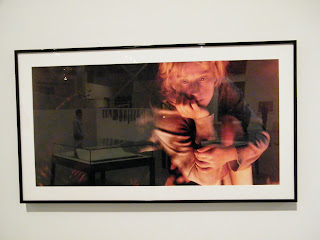
The Geffen in downtown LA is currently playing host to the Los Angeles Museum of Contemporary Art's permanent collection since 1980. The collection includes work from prominent post-modern artists such as Kiki Smith, Lynda Benglis, Felix Gonzalez-Torres, Mike Kelly, Jeff Koons, Kara Walker, Paul McCarthy, Roy Lichtenstein, Robert Rauchenberg, Jackson Pollock, and Cindy Sherman, among many others. Seeing as much of the work we have been discussing in this class appears in this show, in this review I will attempt to chronicle the experience of seeing this art all together in a single show, as well as how the show has been constructed in what I believe to be a level playing field between Western and non-Western art.
First of all, the initial experience of walking into this show is utterly overwhelming. There is so much art on display (all of which is relevant to the history of modern and post-modern art that has been laid out in class), that there is a sense of paralysis concerning the scale of the exhibition, of which the architecture of the Geffen warehouse plays a significant part. Because of the venues extremely high ceiling and temporary walls which barely reach half its height, there is a distinct departure from the experience typically expected from an art exhibition in a major metropolitan gallery. I believe that this choice actually reflects the concerns of many of these post-modern artists, who strived to challenge the role of the art institution and the manner in which art is presented to the public. This show in particular lacks the baroque and pretentious style of presentation which many major contemporary galleries have, simply by favoring a single open space with a distinct lack of decoration, save for the art itself. Having said that, the temporary walls are just thick enough and spaced evenly enough so that the space does not feel too empty and open, which would diminish the interaction between art and viewer. This allows the art to be considered on its own terms, and not in relation to a gaudy context. Therefore, even the architecture itself supports the struggles of many of these artists.
Second, I noticed a distinct lack of cultural bias or a Western superiority complex in the selection of works, and especially in the physical placement of pieces in the show itself. For instance, on the second floor there was a piece by Kara Walker next to a disturbing depiction of a Santa massacre by the ever-shocking Paul McCarthy, which itself was next to the marble statue "Hong Kong Island", by Yukata Sone. All of these pieces had very different approaches to medium and content (although I would argue that all three pieces deal with memories of violence linked to cultural traditions which have been re-appropriated as commodity, whether it be on the large cultural scale for Walker, and Sone, or the individual scale for McCarthy), yet here they are, grouped together with a seemingly purposeful randomness. In my opinion, this allows for the art to be viewed on its own terms, and not as part of a labelled "cultural aesthetic", or some other constructed method of differentiation between Western and non-Western art. Imagine what a shame it would have been if the show had been segregated according to the artists origins (i.e. an Asian section, an American section, a female section, etc.)! I believe that this approach allows for each art piece to have its own impact, on its own terms. This also allows for strong juxtaposition between each art piece and the others around it, instead of a passive categorical grouping.
Therefore, the exhibition of LA MOCA's permanent collection achieves an inclusive nature, not just in the relation between art and viewer, but in the relation between the disparate pieces of art from all over the world. It is amazing to see that so many artists from all around the world are all grappling with issues of art in the age of mechanical reproduction (credit to Walter Benjamin for that highly influential essay, which amazingly is still highly relevant today, and especially to this show), and identity in the digital age. The show runs until May 3, 2010, and I highly suggest that anyone with even the slightest interest in contemporary art go see it. It is a great launching point for further studies into post-modern art, and many of these pieces are very large-scale, something which seeing digital reproductions cannot match (Benjamin would call it the "aura" of the piece - something lost upon digitization or mechanical reproduction). In short, this is a highly successful show, and something which should be visited.







No comments:
Post a Comment